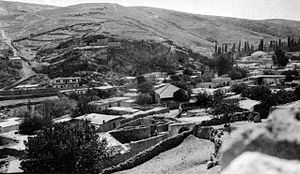| First Battle of Amman | |||||||
|---|---|---|---|---|---|---|---|
| Part of the Middle Eastern theatre of World War I | |||||||
 View across Amman to the Citadel | |||||||
| |||||||
| Belligerents | |||||||
|
|
| ||||||
| Commanders and leaders | |||||||
|
|
| ||||||
| Units involved | |||||||
|
60th (London) Division Anzac Mounted Division Imperial Camel Corps Brigade |
Fourth Army 3rd and 46th Assault Companies 48th Infantry Division 145th and part 150th Regiments German 703rd Infantry Battalion with a cavalry troop, artillery section and Asia Corps machine gun company[1] | ||||||
| Strength | |||||||
| 6,000 troops with 15 guns | |||||||
| Casualties and losses | |||||||
| 1,348 | |||||||
The First Battle of Amman was fought from 27 to 31 March 1918 during the First Transjordan attack on Amman of the Sinai and Palestine Campaign of the First World War. The 60th (London) Division and the Anzac Mounted Division attacked the Ottoman garrison at Amman deep in enemy occupied territory, 48 kilometres (30 mi) from their front line, after capturing Es Salt and Shunet Nimrin. The Egyptian Expeditionary Force (EEF) was successfully counterattacked by Ottoman Empire forces forcing them to retreat back to the bridgeheads captured on the Jordan River.
Following the victories at the Third Battle of Gaza and the Battle of Beersheba, the EEF had pursued the retreating Ottoman armies, fighting successful battles at Mughar Ridge in November and capturing Jerusalem in December. During the winter of 1917/1918 these considerable territorial gains were consolidated and the front line established. In February 1918 the front line was pushed eastwards by the EEF when the right flank of the Jaffa to Jerusalem line was extended by the capture of land from the east of Jerusalem stretching down into the Jordan Valley to capture Jericho. In early March the front line from the Mediterranean to Abu Tellul in the Judean Hills, was pushed north during the action of Tell 'Asur. These two adjustments to the front line were necessary precursors, to advances by Allenby's EEF across the Jordan River and into the hills of Moab to Es Salt and Amman.
The Passage of the Jordan was effected by a British Empire force of Australian and British swimmers, crossing the fast-flowing river while under fire. Pontoon bridges were quickly constructed and the infantry and mounted troops crossed the river to establish bridgeheads on the eastern bank, before advancing up to and across the high country; the infantry moving along the main road with the mounted columns riding on both flanks. They were to cut the railway line to the north and south of Amman by destroying long sections of the Hejaz Railway, including bridges and a viaduct. Amman was strongly defended by the Fourth Army garrison which was further strengthened by the arrival of reinforcements. British Empire infantry and artillery reinforcements from Es Salt strengthened the 181st Brigade and the Anzac Mounted Division's attacking force travelling across difficult and unfriendly terrain. Although the combined force of infantry and mounted troops made determined attacks on Amman over several days, the strength of defence and threats to lines of communication forced a retreat back to the Jordan Valley. The only territorial gains following the offensive were the establishment of bridgeheads on the eastern side of the river at Ghoraniyeh and Makhadet Hajlah.
- ^ Falls 1930 Vol. 2 pp. 348, 655
© MMXXIII Rich X Search. We shall prevail. All rights reserved. Rich X Search
